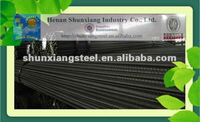- Steel Pipes[3]
- Steel Sheets[10]
- Stainless Steel Sheets[2]
- Stainless Steel Pipes[6]
- Stainless Steel Bars[9]
- Steel Round Bars[10]
- Iron Pipes[8]
- Other Steel Profiles[9]
- Flat Steel[2]
- Steel Rails[1]
- Steel Billets[5]
- Spring Steel[1]
- Stainless Steel Wire[2]
- Steel Wire[1]
- Steel Rebars[7]
- Square Steel[1]
- Metal Building Materials[1]
- Contact Person : Mr. Liu Eric
- Company Name : Henan Shunxiang Industry Co., Ltd.
- Tel : 86-372-3189006
- Fax : 86-372-3189608
- Address : Henan,Anyang,North of Huaxiang Road,Yindu District,Anyang City ,China
- Country/Region : China
- Zip : 455004
HRB500 Hot Rolled Ribbed Construction Reinforcement Steel Bar
Sizes and Grades
Shunxiang Industry supplies HRB335, HRB400 and HRB500 ribbed construction steel bar. You could see the detail information in the table below.
Chemical Composition
Mechanical Properties
Tolerance and Theoretical Weight
Basic Information of Rebar:
A rebar (short for reinforcing bar), also known as reinforcing steel, reinforcement steel, rerod, a deformed bar, reo, or reo bar, is a common steel bar, and is commonly used as a tensioning device in reinforced concrete and reinforced masonry structures holding the concrete in compression. It is usually formed from carbon steel, and is given ridges for better mechanical anchoring into the concrete.
History
Rebars inside the Leaning Tower of Nevyansk.Rebars were known in construction well before the era of the modern reinforced concrete. Some 150 years before its invention rebars were used to form the carcass of the Leaning Tower of Nevyansk in Russia, built on the orders of the industrialist Akinfiy Demidov. The purpose of such construction is one of the many mysteries of the tower. The cast iron used for rebars was of very high quality, and there is no corrosion on them up to this day. The carcass of the tower was connected to its cast iron tented roof, crowned with the first lightning rod in the Western world. This lightning rod was grounded through the carcass, though it is not clear whether the effect was intentional.
Use in concrete and masonry
Concrete is a material that is very strong in compression, but relatively weak in tension. To compensate for this imbalance in concrete's behavior, rebar is cast into it to carry the tensile loads. For this purpose, the steel reinforcement of a concrete structure is, conceptually, divided in two types of reinforcement: primary reinforcement and secondary reinforcement. Primary reinforcement refers to the reinforcement steel which is employed specifically to guarantee the necessary resistance needed by the structure to support the design loads. Secondary reinforcement, also known as distribution reinforcement, is employed for durability and aesthetic reasons, by providing enough localized resistance to limit cracking and resist stresses caused by effects such as temperature changes and shrinkage. It is also employed to confer resistance to concentrated loads by providing enough localized resistance and stiffness for a load to spread through a wider area.
Masonry structures and the mortar holding them together have similar properties to concrete and also have a limited ability to carry tensile loads. Some standard masonry units like blocks and bricks are made with strategically placed voids to accommodate rebar, which is then secured in place with grout. This combination is known as reinforced masonry.
While any material with sufficient tensile strength could conceivably be used to reinforce concrete, steel and concrete have similar coefficients of thermal expansion: a concrete structural member reinforced with steel will experience minimal stress as a result of differential expansions of the two interconnected materials caused by temperature changes.
Physical characteristics
Steel has an expansion coefficient nearly equal to that of modern concrete. If this were not so, it would cause problems through additional longitudinal and perpendicular stresses at temperatures different than the temperature of the setting. Although rebar has ribs that bind it mechanically to the concrete, it can still be pulled out of the concrete under high stresses, an occurrence that often precedes a larger-scale collapse of the structure. To prevent such a failure, rebar is either deeply embedded into adjacent structural members (40-60 times the diameter), or bent and hooked at the ends to lock it around the concrete and other rebar. This first approach increases the friction locking the bar into place, while the second makes use of the high compressive strength of concrete.
Common rebar is made of unfinished tempered steel, making it susceptible to rusting. Normally the concrete cover is able to provide a pH value higher than 12 avoiding the corrosion reaction. Too little concrete cover can compromise this guard through carbonation from the surface. Too much concrete cover can cause bigger crack widths which also compromises the local guard. As rust takes up greater volume than the steel from which it was formed, it causes severe internal pressure on the surrounding concrete, leading to cracking, spalling, and ultimately, structural failure. This phenomenon is known as oxide jacking. This is a particular problem where the concrete is exposed to salt water, as in bridges built in areas where salt is applied to roadways in winter, or in marine applications. Epoxy-coated, galvanized or stainless steel rebars may be employed in these situations at greater initial expense, but significantly lower expense over the service life of the project. Special care must be taken during the installation of epoxy-coated rebar, because even small cracks and failures in the coating can lead to intensified local chemical reactions not visible at the surface.
Fiber-reinforced polymer rebar is now also being used in high-corrosion environments. It is available in many forms, from spirals for reinforcing columns, to the common rod, to meshes and many other forms. Most commercially available rebars are made from unidirectional glass fibre reinforced thermoset resins.
If you need reinforcing bars, please contact us to get a competitive quotation.
HRB500 Hot Rolled Ribbed Construction Reinforcement Steel Bar







